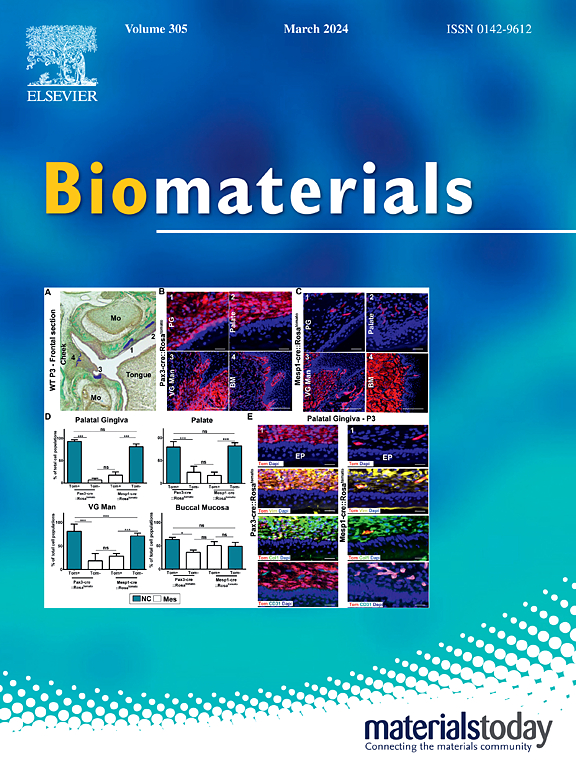Revolutionizing pressure ulcer regeneration: Unleashing the potential of extracellular matrix-derived temperature-sensitive injectable antioxidant hydrogel for superior stem cell therapy
IF 12.9
1区 医学
Q1 ENGINEERING, BIOMEDICAL
引用次数: 0
Abstract
Pressure ulcers are a common issue in elderly and medically compromised individuals, posing significant challenges in healthcare. Human umbilical cord mesenchymal stem cells (HUMSCs) offer therapeutic benefits like inflammation modulation and tissue regeneration, yet challenges in cell survival, retention, and implantation rates limit their clinical application. Hydrogels in three-dimensional (3D) stem cell culture mimic the microenvironment, improving cell survival and therapeutic efficacy. A thermosensitive injectable hydrogel (adEHG) combining gallic acid-modified hydroxybutyl chitosan (HBC-GA) with soluble extracellular matrix (adECM) has been developed to address these challenges. The hybrid hydrogel, with favorable physical and chemical properties, shields stem cells from oxidative stress and boosts their therapeutic potential by clearing ROS. The adEHG hydrogel promotes angiogenesis, cell proliferation, and collagen deposition, further enhancing inflammation modulation and wound healing through the sustained release of therapeutic factors and cells. Additionally, the adEHG@HUMSC composite induces macrophage polarization towards an M2 phenotype, which is crucial for wound inflammation inhibition and successful healing. Our research significantly propels the field of stem cell-based therapies for pressure ulcer treatment and underscores the potential of the adEHG hydrogel as a valuable tool in advancing regenerative medicine.

压疮再生的革命:释放细胞外基质衍生的温度敏感型可注射抗氧化水凝胶的潜力,实现卓越的干细胞疗法。
褥疮是老年人和健康受损者的常见病,给医疗保健带来了巨大挑战。人脐带间充质干细胞(HUMSCs)具有调节炎症和组织再生等治疗功效,但细胞存活率、保留率和植入率方面的挑战限制了其临床应用。三维(3D)干细胞培养中的水凝胶可以模拟微环境,提高细胞存活率和治疗效果。为了应对这些挑战,我们开发了一种热敏注射水凝胶(adEHG),它结合了没食子酸改性羟丁基壳聚糖(HBC-GA)和可溶性细胞外基质(adECM)。这种混合水凝胶具有良好的物理和化学特性,能保护干细胞免受氧化应激,并通过清除ROS提高其治疗潜力。adEHG 水凝胶可促进血管生成、细胞增殖和胶原沉积,通过持续释放治疗因子和细胞,进一步加强炎症调节和伤口愈合。此外,adEHG@HUMSC 复合材料还能诱导巨噬细胞向 M2 表型极化,这对抑制伤口发炎和伤口成功愈合至关重要。我们的研究极大地推动了以干细胞为基础的压疮治疗领域,并强调了adEHG水凝胶作为再生医学重要工具的潜力。
本文章由计算机程序翻译,如有差异,请以英文原文为准。
求助全文
约1分钟内获得全文
求助全文
来源期刊

Biomaterials
工程技术-材料科学:生物材料
CiteScore
26.00
自引率
2.90%
发文量
565
审稿时长
46 days
期刊介绍:
Biomaterials is an international journal covering the science and clinical application of biomaterials. A biomaterial is now defined as a substance that has been engineered to take a form which, alone or as part of a complex system, is used to direct, by control of interactions with components of living systems, the course of any therapeutic or diagnostic procedure. It is the aim of the journal to provide a peer-reviewed forum for the publication of original papers and authoritative review and opinion papers dealing with the most important issues facing the use of biomaterials in clinical practice. The scope of the journal covers the wide range of physical, biological and chemical sciences that underpin the design of biomaterials and the clinical disciplines in which they are used. These sciences include polymer synthesis and characterization, drug and gene vector design, the biology of the host response, immunology and toxicology and self assembly at the nanoscale. Clinical applications include the therapies of medical technology and regenerative medicine in all clinical disciplines, and diagnostic systems that reply on innovative contrast and sensing agents. The journal is relevant to areas such as cancer diagnosis and therapy, implantable devices, drug delivery systems, gene vectors, bionanotechnology and tissue engineering.
 求助内容:
求助内容: 应助结果提醒方式:
应助结果提醒方式:


